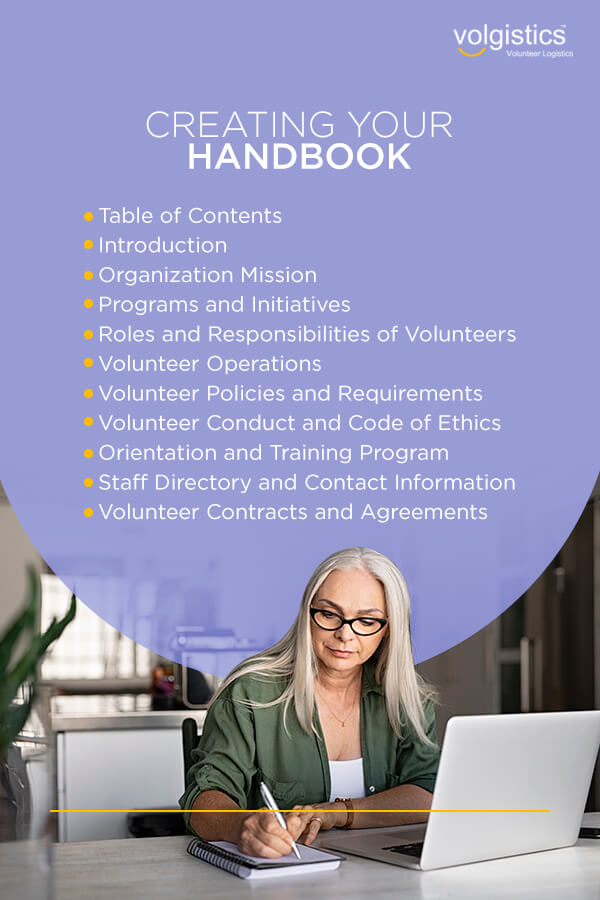Volunteers form the backbone of many organizations, particularly nonprofits. They perform essential work that frees staff members to concentrate on specialized tasks, and they create invaluable links to the community that generate interest and support. Across America, volunteers donate a collective 6.9 billion hours of work annually.
To help your volunteer cohort function effectively, you’ll need to provide training and resources. One of the most valuable of these resources is the volunteer handbook, sometimes known as a volunteer manual or volunteer policies and procedures manual. In this guide, we’ll discuss why engaging, informative volunteer handbooks are so powerful. We’ll also provide a sample volunteer handbook outline and give advice about how to create a volunteer handbook for your organization.

What Are Volunteer Handbooks And Why Are They Important?
Either printed or digital, a volunteer handbook is a valuable resource that clearly states the mission of your nonprofit and how volunteers can help the organization achieve its goals. A volunteer handbook is an essential guide that relays essential information about the nonprofit, what volunteers will do during training, and what’s expected from them as volunteers. It basically answers all of the questions a volunteer might have, so it’s a good idea to distribute volunteer handbooks to volunteers before you deem them official volunteers.
There are a variety of reasons for the importance of volunteer handbooks.
1. They Help Inform Volunteers
When volunteers sign up, they may not know much about your goals or practices. Volunteer handbooks can help cover both broad goals as well as small, important details. Having a handbook available helps orient volunteers and gives them the tools they need to succeed in their daily tasks.
2. They Help Minimize Training Time and Costs
Training volunteers is important, but the costs quickly add up. You may create packets to distribute to each volunteer or send mailings to their homes for training. In addition to being costly, this practice uses valuable time and resources.
A centralized handbook enables you to state important information once instead of sending out multiple information packets, thus conserving resources and funds. It may also allow you to streamline your in-person training so you can focus on essentials and minimize wasted time.
3. They Help Support Volunteers
Volunteer handbooks are a valuable way to support your volunteers. Volunteers are likely to have basic questions during their work, but they may not want to interrupt busy staff members to ask them. A volunteer handbook gives them a place to go for answers. If they need a form, they can check the template section of the handbook. Or if they’ve forgotten the protocols for performing a task, reading the handbook can help refresh their memory. Clarifying volunteer roles and making volunteers feel supported can help increase volunteer satisfaction and retention.

Things to Consider Before Getting Started With Handbooks for Volunteers
Keep your organization and its volunteer base at the forefront with these considerations for developing a volunteer handbook.
1. Formatting
Before creating your volunteer handbook, settle on the format you will use. The format includes the handbook’s design, as well as whether the handbook will be in print or electronic form — or both.
First, decide whether your handbook will be available electronically or in a hard copy. An electronic copy requires fewer resources like paper and ink and can be accessed from different workstations. But some people prefer to read a hard copy, where they are more likely to absorb information and less likely to skim. Weigh these pros and cons before making a decision.
Then, delegate the tasks of designing, editing, and proofreading the handbook. Be sure to use appealing, easy-to-read text to engage volunteers’ attention.
2. Role of Your Volunteers
When you’re processing how to develop a volunteer handbook, consider the roles volunteers play in your organization. Think about whether your volunteers perform the same tasks or whether their duties are tailored to specific support roles.
If your volunteers’ roles are similar, you can easily structure your handbook so it applies to everyone. If not, you may need a separate handbook for each volunteer position. Figuring out how much overlap exists between your volunteer roles and how much individualized instruction is necessary can provide guidance for your handbook structure.
3. Policies and Procedures You Have in Place
Before you create your volunteer handbook, you’ll need to consider the policies and procedures you have in place. Make sure you document all the volunteer policies in your handbook. Consider any procedures for:
- Emergencies
- How to sign up for volunteer times
- How to check in
- How to communicate about absences
- How to determine what tasks are most urgent for the day
Laying out these policies and procedures in the handbook helps make your expectations clear.
4. Contents and Organization of the Handbook
As you’re creating and organizing your volunteer policies and procedures manual, be sure to take these essential steps:
- Gather input: Gather input from various stakeholders if needed. Many people in your organization likely rely on volunteers for assistance, and taking this step helps ensure the volunteer program will meet their needs.
- Collect information: Ensure you gather all information needed before getting started. Collect the various written policies and the procedures for performing necessary tasks. You should also include materials like a welcome sheet and a mission statement.
- Compile links and resources: Compile links to other resources and forms where needed. Include any frequently used documents or templates, as well as online links to suggested reading.
5. Implementation
Implementation involves reviewing the handbook and putting it into practice. Before making the handbook available for use, your organization should answer these questions:
- Who is in charge of reviewing? Delegate someone to review the handbook after its completion. This person can check for omissions, factual inaccuracies, duplicate copy, and contradictory content. The reviewer can also check to see that the handbook is user-friendly and its tone represents the organization well.
- Who should approve the handbook’s contents before its implementation? The volunteer manager will likely want to approve the handbook before it goes into use. The organization’s operations manager, director, or board may also wish to take a look.
- Who should be responsible for updating the handbook? At some point, policies are likely to change, or you may revise longstanding procedures. Designate one person to be responsible for updating the handbook accordingly — that way, you’ll know you have a resource that gives volunteers correct, up-to-date information.
- How often should the handbook be revisited? Determine how often your organization will set aside time for handbook updates. If things tend to change quickly in your offices, you might end up revising the handbook every couple of months. If procedures tend to remain set for a while, a yearly update may be all you need.
- Where will the handbook be available? Determine how volunteers should access the handbook. If you plan to have one hard copy, leave it in a central location where volunteers can easily access it. If you plan to create a digital copy, you’ll probably want to put it in a shared folder on an accessible drive, or share it in your volunteer portal.

Use This Volunteer Handbook Template To Get Started
The question of what to include in a volunteer handbook is crucial. When you start creating, consider these essentials for volunteer handbooks. You can use this outline as a starting point and adjust it based on your organization’s needs.
1. Table of Contents
The first element of our template for a volunteer handbook is the table of contents. In your enthusiasm to start telling volunteers about the exciting work they’ll get to do, it’s easy to overlook small details like the table of contents. Most handbooks contain vast amounts of helpful information, and a table of contents makes it easier for volunteers to find what they’re looking for quickly.
2. Introduction
The introduction is the place to lay out the exciting volunteer opportunities and get volunteers enthusiastic about their roles. It also sets the tone for the relationship between your volunteers and staff. You can use the introduction to make clear how much you value your volunteers and to thank them for their commitment and efforts.
3. Organization Mission
You’ll want to include your organization’s mission statement in the volunteer handbook. It’s easier for volunteers to uphold your mission if they have a clear conception of what it is. Especially if your organization is a nonprofit, you likely already have a mission statement crafted and ready to add.
4. Programs and Initiatives
In this section, you can start getting more specific about the programs and initiatives your organization runs. You’ll want to describe how the programs work and the benefits they have for the community. You can also define the big picture in terms of how volunteers typically contribute and what rewards they see.
5. Roles and Responsibilities of Volunteers
In this section, you’ll want to describe the roles and responsibilities of your volunteers in more detail. If volunteers can choose from different positions, explain the different roles and the work involved. Be sure to spell out the responsibilities of each role so volunteers understand what you’ll need from them once they commit.
6. Volunteer Operations
When you’re thinking about how to create a volunteer manual, volunteer operations is likely a focal point. In your volunteer operations section, provide important details about reporting, processes, procedures, and scheduling.
If volunteers should check in with the volunteer manager as soon as they arrive, let them know that. If they should sign in using volunteer software and pick up their name tag, let them know that too. Give them details about how to sign up for their shifts and how to let you know if they won’t be able to make it. You can also provide details about emergency procedures, training sessions, and how you’ll distribute necessary information going forward.
7. Volunteer Policies and Requirements
Your volunteer induction handbook should let volunteers know what you expect from them in terms of work duties and operations. You’ll increase the likelihood of compliance if you explain why the requirements are in place. Volunteers may be excited to start working in the field right away, but if you explain that completing mandatory training lowers their risk of injury, they’ll understand why they need to wait. If you require volunteer accident insurance, spell out that coverage requirement here as well.
8. Volunteer Conduct and Code of Ethics
When you’re creating your volunteer handbook, remember to address volunteer conduct and your organization’s code of ethics. In this section, specify what principles you expect volunteers to uphold as they work. You can elaborate on your dress code, explain your office’s norms of professional behavior, and lay out the ethics guidelines that inform your work — especially if you interact with vulnerable populations.
9. Orientation and Training Program
In this section, give the details of what volunteers can expect from orientation and training. List the training sessions they must attend and explain why you require the training. Give volunteers the likely schedule for these orientation and training sessions and let them know how they can sign up for specific times.
10. Staff Directory and Contact Information
The staff directory and contact information should be a concise list of essential contact details. Provide the contact information you would like volunteers to use — whether phone numbers, email addresses, or both. If your organization is large, you can add office numbers as well so volunteers know how to locate the staff members they need.
11. Volunteer Contracts and Agreements
In this section, keep the contracts that each volunteer must agree to and sign before beginning work with your organization. These agreements constitute written proof that volunteers agree to abide by your guidelines and regulations. You can refer to the agreements if conflicts arise.
Volunteer Handbook Best Practices
Below are a few best practices for volunteer handbooks:
- Keep it easy: To create an effective volunteer handbook, try to keep the writing at an eighth grade reading level. A simple volunteer handbook with straightforward language is more likely to hold volunteers’ attention, especially when they’re busy.
- Keep it clear and concise: Using short, clear instructions is helpful for holding volunteers’ attention and helping them remember details.
- Consider a mandatory signoff: Do volunteers need to sign off to indicate they have read and understood the handbook? Implementing this requirement helps create volunteer accountability.
- Make it relevant: Make sure the volunteers know how the policies and guidelines apply to them. Communicating only essential information makes it more likely volunteers will remember and use what they read.
- Use a professional-looking format and template: Give your handbook a polished appearance that represents your organization professionally and makes volunteers proud to work with you.
- Use easy-to-read fonts and colors: Making your handbook readable is essential. If it’s easy on the eyes, volunteers are more likely to read it and return to it when they have questions.
- Include a table of contents and page numbers: Including these elements makes it easy for volunteers to find the specific information they need.
- Create customized sections: Consider creating a standard handbook and then customizing certain sections based on the volunteers’ roles. That way, volunteers know which part to turn to for specific details and can skip irrelevant information.
- Include a glossary: Consider adding a glossary if you commonly use acronyms or other terms people may not be familiar with. This can help volunteers take ownership of their learning by looking up meanings for themselves.

Contact Volgistics for All Your Volunteer Management Needs
Tips for creating a volunteer handbook are helpful, but creating a volunteer handbook is just one step in volunteer management. To take advantage of a sophisticated, user-friendly, and comprehensive volunteer management service, partner with Volgistics. The volunteer management platform allows you to recruit, track, schedule, and text and email volunteers — and much more.
Try Volgistics free for 30 days to see how it can streamline your volunteer management. Or schedule a demo today to learn more.

